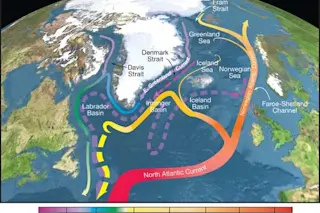Massive volumes of water circulate throughout the Atlantic Ocean and serve as the central drivers of Earth’s climate. Now researchers have discovered that the heart of this circulation is not where they suspected.
“The general understanding has been [that it’s] in the Labrador Sea, which sits between the Canadian coast and the west side of Greenland,” said Susan Lozier, a physical oceanographer at Duke University in Durham, North Carolina, who led the new research. “What we found instead was that … the bulk [of it] is taking place from the east side of Greenland all the way over to the Scottish shelf.”
The discovery will help improve global climate models.
Water courses through the Atlantic Ocean in two layers. A shallow layer pulls warm water from the tropics north. This layer, which includes the Gulf Stream, helps keep winters in Western Europe relatively mild. As the warm waters travel to ...














